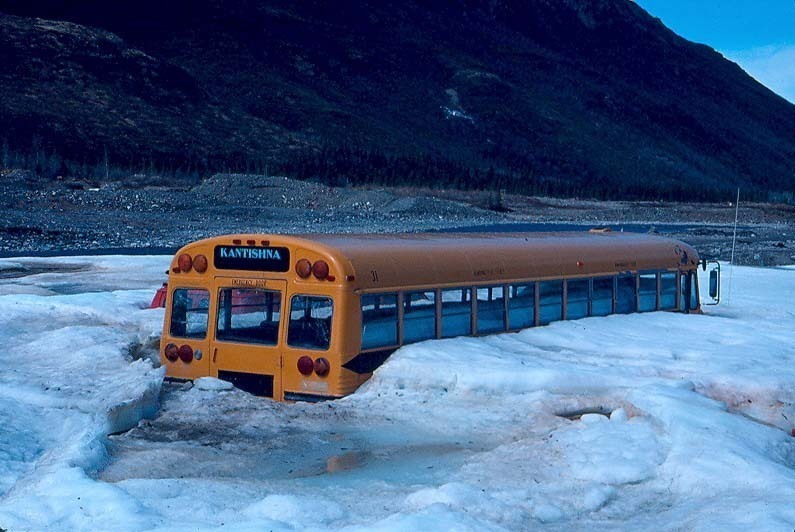It’s springtime in Denali. It snowed for three days in a row last week, today is in the mid-50’s, and just a bit north of our office, the Park’s Spring Road Opening Crew is hard at work plowing the Denali Park Road.
I realized recently that my knowledge of this process was woefully inadequate, and that perhaps it was time I find a more suitable explanation than my theory of aliens simply zapping the road with their magical, snow-melting lasers. My quest to discover “How They Plow the Park Road” complete, I now share my findings with you.
The goal is simple enough: remove snow and ice from the 90-mile road. Ideally, the crew reaches Kantishna by around May 18, which yet allows a few days for the last part of the road to dry out before it is opened to administrative traffic. The crew therefore begins plowing around the third week of March. The total process averages about ten weeks and is tackled by two crews, each consisting of three equipment operators for plowing, and two steam crewmembers for thawing culverts.
The plow team relies on three machines to get the job done: a grader with a snow wing, a D7 bulldozer, or “dozer,” and a front-end loader with a 6-way plow. There is also a flatbed pickup that follows carrying extra gear, oils, tools, and a generator: machinery gets plugged in at night in cold temperatures.
The steam team follows the heavy equipment and is primarily concerned with the culverts. By attaching a steam hose to the steam pipes attached to and inside some culverts, the crew is able to run steam all the way through, which helps melt the ice that has frozen solid inside. When there’s no steam pipe installed, the process becomes more of an art form than an exact science, and it’s a lot of work. Much time is spent getting water away from the road to help it dry and avoid structural damage.
Certain stretches of road often see deeper ice and snow levels. Around mile 4.5, there’s a quarter-mile section where crews have seen ice 12 feet deep in the past. Other tricky spots include mile 17 (just past Savage River), mile 40-41 (just shy of our picnic supper stop), and a long stretch just west of Camp Denali, to name but a few. How does one go about removing 12 feet of ice? In the old days, they drove over it when they could and let it melt, or spread coal ash on it to speed up the process. These days, the dozer uses three ripper shanks—think giant claws (that would humble any grizzly)—to break up the ice so it can be removed by the loader. Recent road projects, particularly at mile 4.5 and in Igloo canyon, have helped significantly in reducing the amount of ice found on those sections of the road.
Toklat marks a significant point in the process for several reasons. First, the timing of their arrival is a good gauge for whether the teams are on schedule. This is also the time to address any equipment maintenance issues. Last but not least, it marks the start of snow country; farther west, snow depths are typically greater than those on the eastern half of the road. Highway Pass often sees drift depths of 12-15 feet, or a bit further west, up to 20 feet. (I might parenthetically add that by park entrance-area standards, this is quite substantial. Skiers and snowmachiners in our east end winter community rejoice at any snowfall exceeding a few inches.)
So with all that snow and ice, does not one wonder how they know where the road goes? Experience. Most of the time they can see an edge or two, but sometimes, they go by feel. The dozer operator is therefore the most experienced member of the team (and also he who has most recently paid his life insurance premium).
Is it dangerous? Yes and no. In much the same way that guides leading hikes in bear country are aware of their situational hazards and take appropriate precautions, so does the road crew. Putting cleats on the dozers helps to reduce slipping sideways, for example. And experience helps operators recognize hazards, such as an “ice lens” that forms on the road itself as surface snow melts and runs down through the snow pack, then freezes on the road surface.
All things considered, it's probably safer than zapping the road with lasers.
Want to read more? Follow the road crew's progress here.
Special thanks to West District Roads Supervisor Brad Ebel for patiently providing all of this information, and also for sharing the bus photo from his own personal collection.
Denali Dispatch
Denali Dispatch is a journal of the goings on at Camp Denali.




